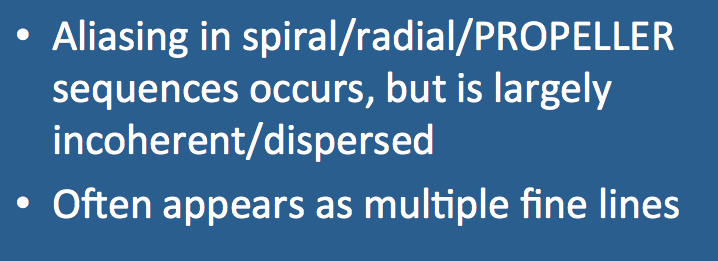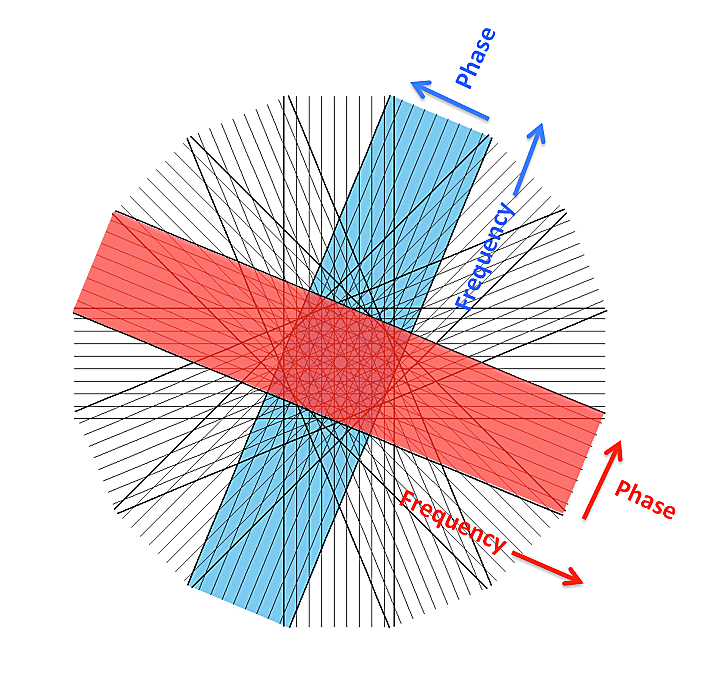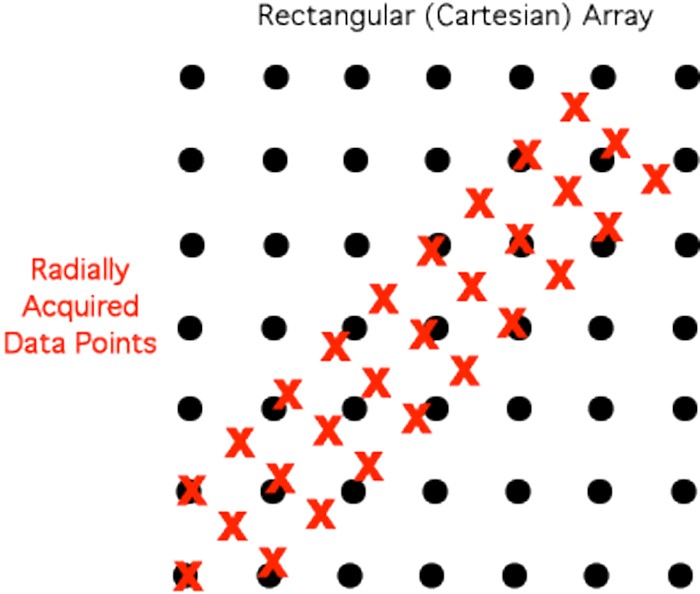Wrap-around and other types of aliasing artifacts do occur in radial/spiral methods, but they have forms different than those seen on rectilinear (Cartesian) scanning.
In most radial and spiral imaging methods, frequency- and phase-axes do not maintain fixed relationships to the cardinal anatomic directions (left-right, superior-inferior, etc.) Instead, phase- and frequency-encoding directions change continually as the trajectory sweeps or rotates around the center of k-space. When aliasing occurs, it usually takes the form of curvilinear bands diffusely distributed across the image, although discrete radially arranged "ghosts" may also appear.
|
A somewhat different form of artifact is commonly seen in the background of PROPELLER images consisting of a diffuse "halo" of fine lines or streaks. These are reconstruction artifacts resulting from gridding, the process where data points acquired in radial/spiral mode must morphed/interpolated to fit into an evenly spaced rectangular array for data processing. With linear interpolation, simple shading occurs across the image, but with higher order interpolation schemes more complex oscillations are aliased into the image. Occasionally these may resemble bright streaks from the edges of high signal objects, similar to those seen around bone or metal on CT.
|
Advanced Discussion (show/hide)»
In "pure" radial sampling using single lines instead of line groups/blades (as in PROPELLER), wrap-around/aliasing artifacts are significantly reduced. This is because pure radial acquisition allows for data oversampling (512 or greater) in all directions without a time penalty. In conventional (Cartesian) imaging, oversampling is confined to a single direction (frequency-encode or readout). Because radial acquisition occurs in all directions, oversampling is not confined to a single axis. Accordingly, the field of view (FOV) can be smaller than the imaged object in radial sampling scheme without aliasing/wrap-around artifacts.
References
Pipe JG. Motion correction with PROPELLER MRI: application to head motion and free-breathing cardiac imaging. Magn Reson Med 1999; 42:963-969.
Patch SK. k-Space data preprocessing for artifact reduction in MR imaging. Multidimensional Image Processing, Analysis, and Display: RSNA Categorical Course in Diagnostic Radiology
Physics 2005; pp 73–87.
Rasche V, Proska R, Sinkus R, et al. Resampling of data between arbitrary grids using convolution interpolation. IEEE Trans Med Imaging 1999;18:385–392.
Pipe JG. Motion correction with PROPELLER MRI: application to head motion and free-breathing cardiac imaging. Magn Reson Med 1999; 42:963-969.
Patch SK. k-Space data preprocessing for artifact reduction in MR imaging. Multidimensional Image Processing, Analysis, and Display: RSNA Categorical Course in Diagnostic Radiology
Physics 2005; pp 73–87.
Rasche V, Proska R, Sinkus R, et al. Resampling of data between arbitrary grids using convolution interpolation. IEEE Trans Med Imaging 1999;18:385–392.
Related Questions
How does PROPELLER reduce motion artifacts?
How does PROPELLER reduce motion artifacts?







